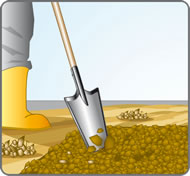Ground preparation before the installation
of synthetic turf

Remove existing grass.
It’s best to use a glyphosphate-based total weedkiller, for fast, effective results. Be sure to follow the instructions.

After having watered the soil, turn it over from 5 – 10cm depth. This will give a stable base for the installation of your synthetic turf.

Level the ground, break up clods, cut off roots and remove debris and pebbles.

Even out the ground, and take out any uneven parts which would not be attractive after the turf has been laid. You have to fill in holes, flatten bumps, and generally try to obtain a surface with gentle contours (or is perfectly flat.

If the soil is very difficult to work, we recommend that you even it, out using a mixture of sand and fine stone chippings.

Compact the soil using a garden roller or a whacker plate. The ground has to be firm to accept synthetic turf.
What to avoid when preparing your ground

Make sure you do not have badly prepared ground, with stones, pieces of wood or roots showing through. Badly prepared soil may cause the rapid degradation of your turf, and spoil the appearance of the finished result.

Avoid leaving holes or cracks. Make sure that the ground is smooth. The presence of holes or cracks may spoil the turf, and allow rainwater to stagnate.

Avoid allowing the water to flow unevenly. Make sure that the soil allows good rainwater drainage. If the soil does not allow for satisfactory drainage, before installation of the turf, spread a layer of river sand (about 5cm deep) to accelerate drainage. Stagnant water may cause the growth of moss on your synthetic turf, and may affect the turf itself.

